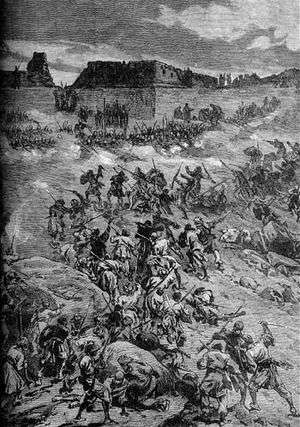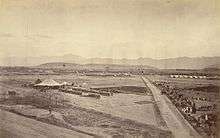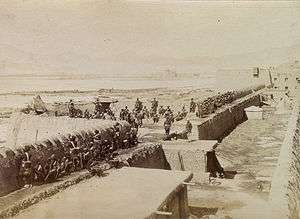Sherpur Cantonment
Sherpur Cantonment, or the British Cemetery, is located in Kabul, Afghanistan. The area was a British military camp or cantonment and the site of the 1879 Siege of the Sherpur Cantonment in the Second Anglo-Afghan War.


The cemetery houses memorials and graves for many fallen western soldiers who fought in various conflicts throughout the history of Kabul. It is managed by an Afghan father and son. They maintain grounds and supervise visitors. The cemetery is enclosed in a tall, fortified wall, which is seemingly unassuming from the exterior. There are various local terms to describe the cemetery. For instance, it is also called Kabre Gora, or "graveyard of foreigners" by locals. While some people call it “Forever England", others call it Sherpur Cantonment. The interesting part about the cemetery is that it’s like a garden inside, so green and beautiful. The garden is now known as the Christian cemetery officially and contains diplomats, adventurers, merchants, explorers, and aid workers from all over the world. There is also a metal sign on the wall of the bend where it is written the "British Cemetery". Furthermore, the wall is so high that one cannot see either inside or outside of the cemetery through the wall. The garden inside is filled with rose bushes and trees. There are three black stone plaques that are placed side-by-side on the cemetery's southern wall. Also, there is an engraved list of those spread across the stones who were killed in the conflict of the past eight years.The mentioned sentences contains the different features and characteristics of this so-called forever England or Christian cemetery.
Historical background
Besides having dead bodies from the second Anglo-Afghan War, there can be found graves dating back to that of 1842 defeat in this cemetery. It dates to over 150 years and contains a strong wooden door. The cemetery was created in the 19th Century, during Britain's past war in Afghanistan where more than 160 soldiers from that period are thought to be buried here. So, they first took the city of Kabul in 1839 with little trouble. It was actually a straight land-grab to stop Russia getting in first.[1] However, an Afghan uprising and rebellion soon began and, two years later, the British were forced out in a now well-chronicled disaster. Nearly the entire Kabul garrison of 16,000 British and Indian troops, their families and servants, were slaughtered by Afghan forces as they tried to retreat. Then, British troops marched back in the same year, razing much of Kabul to the ground in revenge. So basically, the British took Kabul again, but the war lasted several more years and they were back again in 1919. Later, Britain signed a treaty accepting its empire would never stretch beyond the Khyber Pass and granting the Afghans their independence.
Protection of cemetery
The caretaker of the cemetery for over 30 years was an Afghan man called Rahimullah. He was a shepherd and the cemetery grass served as prime grazing for his animals. However, he passed away in 2010, but he advised his son on maintaining the importance of the landmark. Therefore, after his death, Rahimullah's son called Abdul Sami has been tending to the cemetery. Like his father, Abdul Sami has also dedicated his whole life to the cemetery. He told to the Herald that "This place is very nearly not here." He credits his father's devotion, even during the dangerous Taliban rule, for the fact that the cemetery is still standing. Other characteristics of this cemetery is that it is one of the few foreign historical and Christian landmarks that have survived Taliban rule. The earliest graves that can be found lying within the cemetery can be traced back to 1879 and foreigners of all backgrounds have been laid to rest within its compounds. The cemetery serves as a reminder of the history of Afghanistan and the history of an interconnected world.
Best-known residents of the graveyard
Aurel Stein, a British-Hungarian archaeologist, and Henning Christensen, a famous Danish explorer, both died in the 1940s and are buried here in Kabir Gora. There is another grave here with Russian script[2] which turns out to be a Kazakh who fled to Kabul in the aftermath of Russia's 1917 Bolshevik revolution.
Fundraising for the graveyard
The cemetery is not formally recognized by the Commonwealth War Graves Commission and is still owned by the city of Kabul. However, Col Simon Diggins, the British defence attaché who coordinates fundraising for the cemetery, described it as a "labour of love" He mentions: "It's very important to us. "It would be great to think that in ten years’ time, families might be able to come out here and see it and enjoy the tranquility.” (D.S. Col)[3]
Gallery
Sherpur Cantonment at present
-2.jpg) Western Troops Pay Respects
Western Troops Pay Respects-4.jpg) Memorial Inside Kabul's British Cemetery
Memorial Inside Kabul's British Cemetery-8.jpg) View inside of Sherpur Cantonment
View inside of Sherpur Cantonment
Sherpur Cantonment in 1879
 Portrayal of the assault on the Sherpur Cantonment.
Portrayal of the assault on the Sherpur Cantonment. Durbar Maidan of Sherpur Cantonment.
Durbar Maidan of Sherpur Cantonment. Bengal Sapper and Miners Bastion, in Sherpur Cantonment circa 1879
Bengal Sapper and Miners Bastion, in Sherpur Cantonment circa 1879